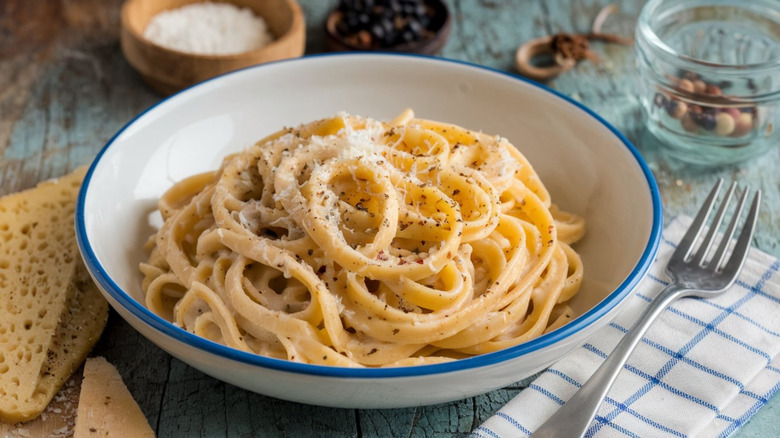Anthony Bourdain's Favorite Pasta Dish Is A Tried And True Classic
Anthony Bourdain was scathing when he unloaded on food and food trends he couldn't stand, and he was just as unrestrained in publicly heaping praise on those he liked. So we know the popular fast food chain that Anthony Bourdain truly loved, and that he was a fan of negronis. When it came to pasta, the late celebrity chef was also effusive about his favorite, the iconic Roman dish cacio e pepe.
Closest to Bourdain's heart in particular was the cacio e pepe at Rome's Ristorante Roma Sparita, where it comes served in a Parmigiano Reggiano cheese bowl. When he ate it on the 2010 "Rome" episode of his Travel Channel show, "No Reservations," he said it "could be the greatest thing in the history of the world." He spoke about things from his life he'd give up for it, including his first sexual experience, and refused to divulge its name so it wouldn't be overrun by hordes of tourists. The restaurant was eventually revealed, and Roma Sparita now has the video clip of his visit posted on its website.
Cacio e pepe, which means cheese and pepper in Roman dialect, inspires such devotion with just four traditional ingredients: pasta, pasta water, freshly-ground black pepper, and Pecorino Romano cheese. But the dish that is sometimes called Italy's version of mac and cheese is deceptively simple. The minimal ingredients combine into a luscious, savory dish with punches of bold flavor from the sharp, salty cheese and pungent black pepper, and the cheese emulsifying into a silky, creamy sauce.
Cacio e pepe is trickier to make than it appears
Cacio e pepe is made by cooking the pasta — customarily a long pasta like spaghetti or tonnarelli, which they use in Rome – and then simmering some of the starchy pasta water with black pepper. The pasta goes in the peppery water and pecorino cheese is added while stirring, the starch working the magic that emulsifies the cheese and water to coat the pasta. Just as the short ingredient list belies how much flavor it packs, its simple cooking steps mask that cacio e pepe can be finicky, and it's easy to end up with a clumpy mess instead of a smooth, rich sauce.
One of the keys is adding the cheese a little at a time instead of all at once, and ensuring the pan isn't too hot to prevent the cacio e pepe sauce from breaking. It's also important that the pecorino is finely grated, and it helps to buy high-quality pasta, which produces starchier pasta water. (Choose better store-bought pasta with an easy visual test.) Toasting the peppercorns before grinding them will add more depth of flavor.
Cacio e pepe is one of the four classic Roman pastas, along with carbonara, alla gricia, and amatriciana, that have time-honored ingredients and preparations. But some cacio e pepe recipes will bend tradition by adding butter to the sauce, including Anthony Bourdain's beloved Ristorante Roma Sparita version, which not only adds flavor but helps the sauce come together. Other recipes will include Parmigiano Reggiano cheese, use olive oil, or even add garlic.

